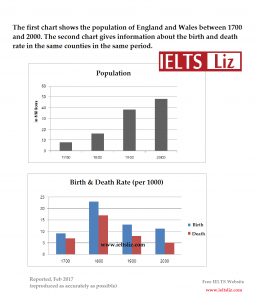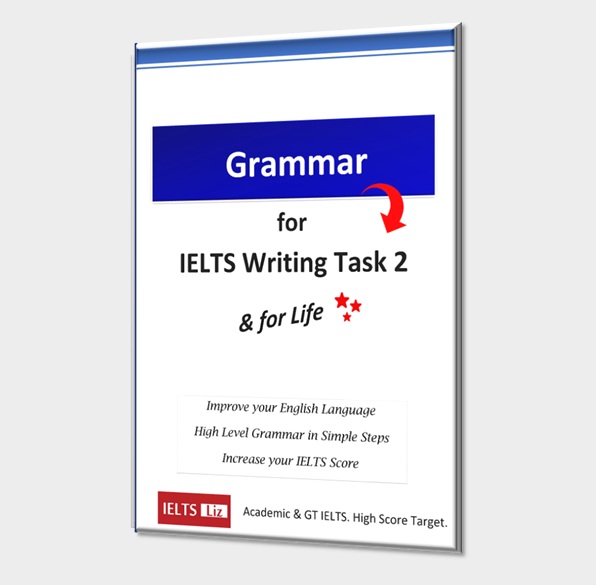Below is an IELTS writing task 1 answer for 2017. The bar charts were reported by a student in February 2017 and recreated as accurately as possible. Please remember that IELTS do not release question or answers for each test. So, all reported tasks and questions are from students who have recently taken the test and have recreated their questions.
You can find links to more model answers for writing task 1 on this page: IELTS Writing Task 1, model answers & tips
IELTS Writing Task 1 Bar charts 2017
Download the above writing task 1 as pdf: IELTS 2017 Writing Task 1
IELTS Writing Task 1 Answer 2017
The two bar charts illustrate the population growth as well as the birth and death rates in England and Wales between 1700 and 2000. The population is given in millions, while the birth and death rates are per 1000 people.
Overall, there was a dramatic increase in the population of England and Wales over the 400 years. The birth and death rates initially witnessed a growth but then steadily declined over the period given. The birth rate was constantly higher than the death rate over the period given.
The population of England and Wales stood at under 10 million in 1700 which then doubled to around 15 million in 1800. By 2000, the figure had reached a high of almost 50 million, almost 5 times that of the population in 1700.
The birth rate was just under 10 per 1000 in 1700 and rose dramatically to peak at over 20 per 1000 in 1800 before dropping to slightly over 10 in the final century. The death rate showed a similar trend but was between 5 and 10 per 1000 less than the birth rate at all times.
187 words (I have put the word count for you. You shouldn’t do this in the test.)
Would you like to see more model answers for writing task 1? See the main pages below and click on IELTS Writing Task 1
Main IELTS Pages
Click to see more tips and practice lessons for IELTS:
- IELTS Listening
- IELTS Reading
- IELTS Writing Task 1
- IELTS Writing Task 2
- IELTS Speaking
- Vocabulary for IELTS







The given bar charts depict the population trends in England and Wales from 1700 to 2000, as well as the corresponding birth and death rates. The population is given in millions, and the rates are per 1000 people.
Overall, there was a significant increase in the total population throughout the entire period, especially around 1900, while the birth and death rates experienced their highest points around 1800. The birth rate was constantly higher than the death rate over the period.
In terms of population figures, the counties initially had a relatively small number of residents, with around 10 million people in 1700. This number then rose to approximately 15 million by 1800. Notably, the total population tripled, reaching nearly 40 million in 1900, and subsequently just under 50 million in 2000.
Regarding natality, the birth rate remained relatively stable and below 15 per 1000 individuals in the years 1700 and 1800. However, in 1900, it witnessed a significant increase, reaching a rate of almost 25 births per 1000, and then it fell again below 15 in 2000. Similarly, the mortality rate exhibited a similar pattern, with a peak of fewer than 20 deaths per 1000 in 1900.
The first chart depicts the information about inhabitants of England and Wales from 1700 to 2000. Whereas the other bar chart represents the data of birth & death rate in both the nations during the same period respectively.
After analysing the first bar graph, it can be seen clearly that the population is increasing from the beginning. As it was around 8 millions in 1700 and apparently it roses to about 15 millions in 1800. And it continued to grow and reaches approximately to 38 millions, moreover it hit almost 50 millions in 2000.
The other graph illustrates that in 1700 the birth rate was about 8(per 1000) and death rate was near to 6 (per 1000). However both rates were increasing as the birth rate reached around 23 (per 1000) and death rate was almost 16 (per 1000). Furthermore the birth rate in 1900 & 2000 remained more than 10( per 1000) whereas death rate in these specific years was ls less than 10 (per 1000)
Overall, population in the first graph were constantly increasing and in the other graph birth rate was more than the death rate.
There are two charts, one of them gives information about the number of people in England and Wales in the years (1700-2000), and the other gives information about the birth and death rate of people in the same countries and in the same period of time. The population chart is given in millions and the birth and death chart in per 1000 people.
Overall, the number of people was increasing significantly over the period given. The rate of birth and death was the highest in 1800. The rate of birth in 1700 and the death rate in 2000 were the lowest. Generally, the death rate was always less that the birth rate.
In terms of population, the number of people in 1700 was around 7 millions, then in 1800, it increased to around 15 millions. The population continues its increasing and reached to around 38 millions while it was the highest in 2000 (~ 48 millions).
In 1700, the birth and death rates were 9 and 7 per 1000, respectively. Both of these rates increased to a peak (around 23 and 17 per 1000, respectively) in 1800. Then, the rates gradually decreased in the rest of the years. A rate of 5 per 1000 was the lowest and accounted for the number of dead people in 2000.
The above two charts illustrated the total number of populations in a million between the years 1700 and 2000 and birth and death rates per 1000 in the year between 1700 and 2000 in England and Wales.
Overall, it can be seen from the bar chart that the number of populations increased from 8 million to 18 million in 1700 and 1800 respectively and raised to 38 million in 1900 and 48s in 2000 and birth rates were almost higher in all of the years.
Firstly, births were observed at a more significant percentage as compared to death in years between 1700 and 2000 starting from the 9 billion births in and a total of around 6 billion deaths occurred in the year 1700. In contrast, the birth rate was among the greatest in the year 1800 which is 22 billion per year and followed by only 17 % deaths. Last and not the least in 1900, a total of 13 % of births and 7 billion deaths happened and in the end, it was only 5 billion deaths in relation to 11 billion births.
The bar charts depicts the number of people in the UK cities and about the birth and death rate from 1700 to 2000.units are presented in millions and per1000.
Overall, it can be seen that the number of people increased in 200 while they decrease in 1700.
The majority of people who was born and died was in 1800.the death rate had the lowest in 2000.
The number of individuals started at the lowest in 1700(8million).the cities continue to get higher in 1900(39millions) as well as in the 2000 were the population rise up speedily to 48millions.
The individuals who were born in the 1700 was less( 8 per1000) as same as the death rate (6per1000). They increased sharply to 22per 1000 in 1800 and decrease significantly to 11per 1000 in 2000. Furthermore,the people that died in 1900 was low as 7per 1000 which reduce to 5per 1000 in 2000.
this message is added for the previous one:
Also, I can see the phrase “the population of England and Wales” as well as the word”population” are twice and 3 times respectively in the essay. IS that okay? or we can replace them with English and Welsh people/citizens?
Regards
You do not need to keep changing words. Choose which words to change and keep the others the same.
Hy Liz, are there any other questions writing task 1 for 2017 except this topic above?
I rely on students reproducing their test questions – not many do that. IELTS do not release them.
Hi Liz,
I can’t ask you to evaluate the complete task. However, is it possible for you to answer few specific questions:
1. Is my usage of the word ‘data’ right in the introduction ?
2. In body paragraph 1, the sentence that I’ve started with ” However, the increases from 1700 to 1800 and from 1900…..”. Is it fine to write this data point ? Or am I over-analyzing the first chart !?
3. Is the usage of brackets fine in body paragraph 2 ?
4. Any other point of improvement that you can suggest ? Any glaring mistakes ?
Real IELTS is really around the corner, so bit nervous.
2 charts are illustrated for England and Wales counties and the period considered is between 1700 and 2000. The first chart illustrates the population and the second chart shows data regarding birth and death rates.
Overall, the number of people increased consistently over the years with 2000 being the year with highest population. However, the birth and death rates peaked in 1800 and decreased thereafter.
The population almost doubled during the period of 1800 to 1900, moving up from approximately 15 billion to about 38 billion. However, the increases from 1700 to 1800 and from 1900 to 2000 are similar and lie in the range of about 7 to 10 billion.
The number of births ( per thousand) has always been greater than the number of deaths (per thousand). The rate of people born is the highest in year 1800 and lowest in 1700.
On the contrary, rate at which individuals died rose to its peak in 1800 but was observed to be lowest in the year 2000.
Review my model answers and you will learn: https://ieltsliz.com/ielts-writing-task-1-lessons-and-tips/
Hello Liz.
Your videos and lessons are amazing.
I have a question regarding this graph. Can we write “Overall, there HAS BEEN a dramatic increase in population… .”? Is it alright to explain all the facts of this graph in this way?
Thank you.
If the dates are in the past, use past simple – there was a dramatic increase.
Can you comment on my Writeup :
Above two bar graphs indicate the population changes and comparative analysis on death and birth rates(between 1700-2000) in England and Wales.
Clearly, there was a constant increase in the population around 7 million in 1700 and about 48 million in 2000. In the first two centuries, a reasonable increment was observed. However, in the last two centuries, this figure was three times or so, than the previous.
Throughout the reported duration, the birth rate was higher, with a record value of about 22(per 1000) in 1800. On the other side, death rate keeps on changing with a nominal value of 16(per 1000) in 1800 and drop-off to 5(per 1000) in 2000.
How can i sign up with you for personal training am taking ielts on the 20th May
Hi, at present the only extra training I offer are my advanced writing task 2 lessons: http://subscriptions.viddler.com/IELTSLizStore
It says over a period of 400 years. Please help me understand how 1700 – 2000 is 400 years and not 300.
It includes: 1700, 1800, 1900 and also the century of 2000. Each bar is one whole century.
Hi Liz, this is a tricky one. 2000 is not yet finished but it is consider as a whole century. Is it a estimated figure? Is it not necessary to change the tense of the verb for that reason?
Thank for your help.
Good thinking – I hadn’t thought of that one. It is certainly a misleading bar chart.
hello liz,
even after following your tips , im failing to score 7 in writing. what should i do next?
Did you think of getting one of my advanced writing task 2 lessons? They explain the techniques in great detail: http://subscriptions.viddler.com/IELTSLizStore. Are you also sure that you are writing to avoid errors? This means not taking chances with sentences that are too long and not using vocabulary that you are not 100% sure about in context and with collocations? The more errors, the lower your score.
the first time i took the exam i got 7.5 in writing but the scores could not be clubbed as i scored just a 6 for reading in that exam. no scores can be below 6.5 and i need a 7 in writing next time. some say that conclusion is important for task 1 others say that overview is essential. i am confused
The examiner is looking for an overview in task 1 and a conclusion in task 2. The overview can be written after the introduction or at the end of the report. Some teachers call the overview a conclusion – it’s just the name they give – which is very confusing for students. The overview is a statement which contains all the key features of the graph or graphs given to you. See this page: https://ieltsliz.com/ielts-writing-task-1-lessons-and-tips/
Hi liz,
Firstly, I really appreciate your blog and the way you are managing to reach every individual students and addressing their queries. You are an awesome teacher i have ever met, having blessed teaching skill. Many thanks for using your ability fruitful for us.
I have my IELTS date for 29th April, 2017. Aiming to get band score 7 to 7.5, I joined to a tutor but the instruction, provided by tutor and your blog is completely different, lets say controversial to each other. Its quite hard for me but I have decided to follow your lesson and practice accordingly rather than what I learned from my regular class.
wishing all the best for me, 🙂 hoping for the good. Thank you once again.
Best Regards
Suvechya Lamichhane from Nepal.
Good luck! Always follow advice which is logical and which adheres to the band score descriptors published by IELTS.
Hello Liz,
I want to appreciate you for your wonderful tutorials, tips and responses to our countless questions here.
I got my test results this morning LRW (7), S(7.5).
This is my first shot on IELTS, although I’ve written PTE-A twice.
I coupled preparation with work,looking after 2 kids, an eight months old, and less than three years old including looking after an octogenarian who was living with me then
Thanks so much for being so helpful. May God perfey your health and grant you your heart desires.
Sade ( Nigeria).
Well done, Sade!! Thanks for sharing your results. It’s an inspirational to others out there who are also juggling many responsibilities and don’t have the time to dedicate to learning IELTS. Your score shows it is possible to achieve great results when you utilise your time effectively. I’m so pleased for you 🙂
Guys!!!!!
Sorry to sound off-topic but this may really boost up your preparation and motivate you to study harder and more efficiently for your IELTS!!
My IELTS prep teacher mentioned to us about this movie.
For Indians/ South Asians who can understand Hindi, I don’t need to mention it again – watch “English Vinglish” – a story about a woman who was mocked for her inability to communicate in English and how she overcame this setback of hers by enrolling in an English preparatory course. [similar to IELTS course, eh?} This movie is full of positive energy and vibes and shows how learning a new language can change your life and make you feel good about yourself as it opens up opportunities.
For non-South Asians, please watch this movie with English subtitles. It will really inspire you – especially those who are struggling to get the desired Band score. And yes, Liz this includes you too. You could use this movie to inspire your students. I am listening to this movie’s songs 24-7.
Thanks for sharing 🙂
Thanks a million Liz. Your page is extremely helpful for me.
What l am not clear is the second sentence of second paragraph. “Birth and death rates initially witnessed a growth but then a steadily declined over the period given.” I have not seen any noun after *a steadily declined*. Would you mind explaining it?
Well spotted. I’ve just altered it. Check it again 🙂
Thank you very much! 🙂
I had the same question.
Thank You Alíz,Hope You well,I learned a lot from your webside they are morning night time With me so glad 🙂
Dearest Liz
I am getting ready for my IELTS Academic test on Saturday – thank you sooooo (I know that isn’t IELTS spelling) much for all the fantastic videos, tips and especially the 50% discount. Now I have all 3 videos now. I just HAVE to pass on Saturday – with Band score 7 as I have a scholarship riding on it.
I read somewhere that you have not been well, I am so sorry to hear that and hope you are feeling better soon. Take care of yourself. And thanks again. TTFN
Sorry, I think I just gatecrashed Szilvia’s post. My apology!
Karen
Keep your eye on the clock in reading and writing! Make sure you manage your time well. Remember that about 50% of your marks in writing is about addressing the issues in the question, developing ideas and organisation – so spend time planning your essay. Also remember that grammar and vocab mistakes will reduce your score. That means, check your essay and don’t take chances. See my last minute tips for each part of the test: https://ieltsliz.com/ielts-exam-tips-on-the-day/. Good luck!
Hi Liz
I owe you! Thanks for a very helpful site. I followed your tips above, bought all your advanced lessons, practiced practiced and practiced. I achieved band scores of 7.0 in reading and writing
9.0 in speaking and 8.5 in listening…overall 8.0.
I know I would never have gained these scores without practicing.
Thank you from the bottom of my heart.
Thank you to all the feedback from your followers too.
Karen
That really makes me pleased to know you hit band 7 in writing. It isn’t easy! Well done 🙂
Hi Liz,
which way is a correct way: 10 millions or 10 million?
Thank you!
10 million without “s”. I’m glad you are paying attention to this because it is the most common mistake people make in English and in IELTS writing task 1.
Hi Liz,
Thank you very much for your enthusiasm in delivering such a wonderful free Ielts website. The web is amazing and you are so fabulous. I bought videos on writing task 2 and they are also perfect (more than perfect, I must say).
Relating this writing task 1, could you please let me know:
– When reporting number of population size, which is measured in millions, is it correct to write as 8 millions, 10 millions instead of 8 million, 10 million (without “s”).
– In order to avoid using key words repeatedly, is it ok to use the word ratio instead of rate; under the given period or throughout the period under the study instead of over the period given.
– In paragraph 3, is it ok to write “almost 5 times higher than that of the population in 1700”.
Thank you so much.
You’re the second student that highlighted the “s” in numbers. It’s good that you are noticing this. Here are examples of correct English:
1) 25 million people (no s)
2) millions of people (with s)
You will see that there is no “s” in the first example because there is a number given. But in the second example, no number is given and therefore the “s” is used. Always remember this rule.
The word ratio is not the same as rate. It can’t be used as a synonym in writing task 1. If you want to paraphrase “over the period given”, you can use “during the given period” or “throughout the time given”. Don’t use your examples. You can also mention the total years “over the four centuries given”. Yes, it’s ok to write as you suggested in the 3rd paragraph.
I’m so glad to hear you found my advanced writing task 2 lessons so useful. I tried to fill the lessons with as many tips and logical techniques as possible to guide students towards the higher scores 🙂
thank you , this was very helpfull .
helpful,sorry.
This is so useful
Thanks
Thank you so much Liz , for valuable writing instruction.
Hi Liz,
thanks for your valuable information and updates.
regarding the answer I think the third paragraph should write 50 millions instead of 60 millions .
Yes, it’s just be altered. Thanks 🙂
Good morning
I want to study english with you I watch your video and i’m follwing you in facebook if this possible contact me par email.
Hi Liz,after buy your video,how can I get the video links by email?Need I send my email address and pay information for you?And I come from China,so the Gmail may not available.Thanks